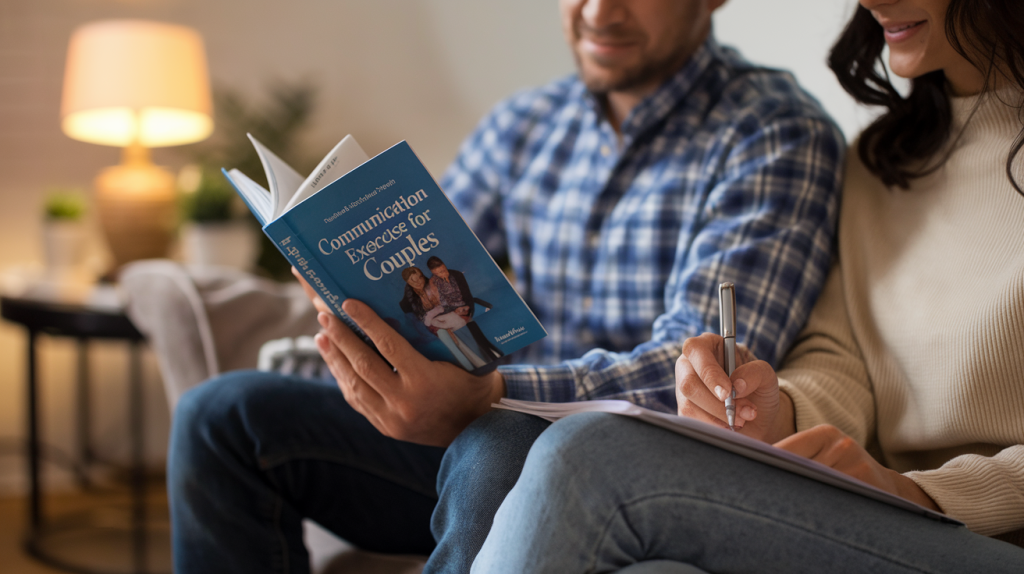Talking with your partner might seem natural, but strong communication needs time and practice.
Many couples face moments when words don’t come easy, or messages get mixed up.
But the good news is that you can make your talks better with simple exercises that bring you closer. These communication exercises work like small steps toward better understanding.
Think of them as tools that help you share thoughts, listen well, and build trust with your partner. They give you fresh ways to express feelings and solve problems together.
You’ll find exercises for different situations – from daily check-ins to working through tough spots.
Let’s explore some of the practical ways listed below to grow closer through better talks.
1. Daily Check-in Chat

Your days get busy, and sometimes, you forget to connect with your partners, right? So, a daily check-in builds a strong foundation for open talks. This simple practice helps you understand each other’s ups and downs.
Many couples find that regular check-ins reduce stress and prevent small issues from growing bigger. These talks create a safe space where both partners can share without fear of judgment.
Time Required: 15-20 minutes
| Step | Action |
|---|---|
| 1 | Pick a time that fits both schedules (e.g., during breakfast or before bed) |
| 2 | Find a quiet spot and remove all distractions (e.g., phones or TV) |
| 3 | Share the main points of your day – both good and bad moments |
| 4 | Listen to your partner without trying to solve their problems |
| 5 | Ask questions to better understand their feelings |
| 6 | End the chat by sharing one thing you look forward to tomorrow |
Tips for Success
- Keep the tone light and friendly
- Skip blame words
- Show interest through body language
- Make this a daily habit, even if it’s just for 10 minutes
2. Active Listening Practice

Most people think they listen well, but often, they’re just waiting for their turn to talk. Active listening means giving your full attention to understanding your partner.
This exercise helps build trust and makes your partner feel valued. When you practice active listening, you catch details you might usually miss.
Time Required: 15 minutes (3 minutes each turn, plus discussion)
| Step | Action |
|---|---|
| 1 | Choose who speaks first and set a timer for 3 minutes |
| 2 | Speakers share about any topic they choose |
| 3 | The listener maintains eye contact and stays quiet |
| 4 | After time’s up, the listener repeats the main points they heard |
| 5 | Speaker confirms if the summary was right |
| 6 | Switch roles and repeat |
Tips for Success
- Focus on understanding, not planning your response
- Notice your partner’s tone and body language
- Stay present in the moment
- Ask for clarity only after your partner finishes
3. Appreciation Exchange

Small acts of kindness often go unnoticed in relationships. This exercise brings attention to these moments and builds positivity between partners.
Regular appreciation helps create a positive atmosphere and strengthens emotional bonds. It reminds both partners why they chose each other.
Time Required: 10 minutes
| Step | Action |
|---|---|
| 1 | Set aside 10 minutes of quiet time together |
| 2 | Sit where you can see each other clearly |
| 3 | Take turns sharing three specific things you liked about your partner today |
| 4 | Include how these actions made you feel |
| 5 | Listen without downplaying the appreciation |
| 6 | Thank each other after sharing |
Tips for Success
- Be specific about actions, not general traits
- Share different things each day
- Include small gestures, not just big actions
- Keep a daily appreciation note on your phone
4. Question Time

Even long-term couples can learn new things about each other. This exercise brings back the curiosity from the early dating days. It helps couples grow together and stay interested in each other’s thoughts.
These questions can lead to fun chats or deep discussions.
Time Required: 20-30 minutes
| Step | Action |
|---|---|
| 1 | Each person writes three questions they want to ask |
| 2 | Mix up the questions and take turns picking one |
| 3 | Both partners answer each question fully |
| 4 | Ask follow-up questions to learn more |
| 5 | Share thoughts about any surprising answers |
| 6 | Keep note of topics you want to explore more |
Tips for Success
- Mix light and serious questions
- Avoid questions that might start arguments
- Show real interest in the answers
- Create a list of future questions
5. Emotion Word Game

Many people struggle to name their feelings clearly. This game builds better emotional awareness and helps partners express themselves. Understanding emotions leads to better support for each other.
It also reduces misunderstandings that come from unclear feelings.
Time Required: 15 minutes
| Step | Action |
|---|---|
| 1 | Each person names one main emotion from their day |
| 2 | Share what caused this feeling |
| 3 | Describe how you dealt with the emotion |
| 4 | Tell your partner what help you needed then |
| 5 | Discuss better ways to handle similar feelings |
| 6 | Plan how to support each other next time |
Tips for Success
- Use specific emotion words
- Share both positive and hard feelings
- Accept emotions without judgment
- Practice naming feelings daily
6. Role Reversal Talk

When partners disagree, they often stick to their own views. This exercise helps you see things from your partner’s perspective. By taking on each other’s roles, you gain a new understanding.
Many couples find this method helps reduce arguments and builds empathy.
Time Required: 30 minutes
| Step | Action |
|---|---|
| 1 | Choose a recent minor disagreement to discuss |
| 2 | Each person states their partner’s position and feelings |
| 3 | Switch roles and act as your partner would |
| 4 | Have a conversation from these switched positions |
| 5 | Share what you learned from being in your partner’s shoes |
| 6 | Discuss new ways to handle similar situations |
Tips for Success
- Stay respectful when playing your partner’s role
- Focus on understanding, not winning
- Be honest about what you learn
- Pick small issues to practice with
7. Silent Signals System

Words aren’t the only way to communicate. This exercise creates special signals for common needs or feelings. Having private signals helps couples stay connected in public settings.
These signals can prevent misunderstandings and show support quietly.
Time Required: 10 minutes to set up, practice daily
| Step | Action |
|---|---|
| 1 | List common situations where signals could help |
| 2 | Create simple hand signals or gestures together |
| 3 | Assign clear meanings to each signal |
| 4 | Practice using signals at home first |
| 5 | Test them in real situations |
| 6 | Review and adjust signals as needed |
Tips for Success
- Keep signals simple and clear
- Make them natural-looking
- Use them consistently
- Start with just a few signals
8. Memory Lane Walk

Sharing good memories brings couples closer. However, this exercise helps you remember what made you fall in love. It builds positive feelings and reminds you of your strong points as a couple.
Regular memory sharing keeps your connection fresh.
Time Required: 30-45 minutes
| Step | Action |
|---|---|
| 1 | Set aside 30 minutes of quiet time |
| 2 | Each person picks three happy memories to share |
| 3 | Take turns telling these stories in detail |
| 4 | Share why these moments matter to you |
| 5 | Discuss feelings these memories bring up |
| 6 | Plan to create new special moments |
Tips for Success
- Include both big and small memories
- Share new stories each time
- Listen with full attention
- Add details you remember, too
9. Finish My Sentence

This exercise tests how well you know each other’s thoughts. It helps couples practice predicting their partner’s needs. The game format makes serious communication fun and light.
It often leads to laughs and surprises.
Time Required: 15-20 minutes
| Step | Action |
|---|---|
| 1 | Create a list of sentence starters about feelings or wishes |
| 2 | One partner starts a sentence |
| 3 | The other tries to finish it correctly |
| 4 | Compare the guess with the real ending |
| 5 | Discuss any surprising differences |
| 6 | Switch roles and continue |
Tips for Success
- Keep sentences about everyday topics
- Don’t worry about perfect answers
- Learn from wrong guesses
- Make it fun, not a test
10. Weather Report Check

This simple method helps share moods without long talks. It gives partners a quick way to understand each other’s state of mind. Using weather terms makes it easier to express complex feelings.
This works well for busy days when time is short.
Time Required: 5 minutes
| Step | Action |
|---|---|
| 1 | Pick a time for daily weather reports |
| 2 | Use weather terms to describe your mood |
| 3 | Add a brief reason for your weather |
| 4 | Share if you need support |
| 5 | Acknowledge your partner’s report |
| 6 | Plan responses for different weather types |
Tips for Success
- Be honest about your weather
- Accept all weather reports without judgment
- Learn what helps each weather type
- Keep updates short but meaningful
11. Five-Minute Focused Talk

Short, focused talks help busy couples stay connected. This exercise fits into packed schedules while keeping communication strong. It proves that meaningful talks don’t need lots of time.
These quick chats prevent feelings of distance in busy times.
Time Required: 5 minutes
| Step | Action |
|---|---|
| 1 | Set a timer for exactly five minutes |
| 2 | Choose one specific topic to discuss |
| 3 | Share your main thoughts quickly but clearly |
| 4 | Listen actively when your partner speaks |
| 5 | Summarize what you both shared |
| 6 | Plan when to continue if needed |
Tips for Success
- Stick to one topic only
- Watch the time
- Be clear and direct
- Save complex issues for longer talks
12. Touch and Talk

Physical touch can make talking easier. This exercise combines a gentle touch with conversation. Many couples find touch helps them feel safer sharing feelings. It creates a physical and emotional connection during talks.
Time Required: 20 minutes
| Step | Action |
|---|---|
| 1 | Sit close enough to hold hands |
| 2 | Make physical contact that feels right |
| 3 | Choose a topic to discuss |
| 4 | Keep contact while talking |
| 5 | Notice how touch affects your talk |
| 6 | Share how the contact made you feel |
Tips for Success
- Choose comfortable touch
- Stay connected throughout
- Focus on both touch and words
- Respect comfort levels
13. Paper Message Exchange

Writing thoughts can be easier than speaking them. This exercise gives space to think before sharing. It works well for partners who process thoughts differently. Written words can reduce emotional reactions during hard talks.
Time Required: 25 minutes (5 minutes writing, 20 minutes discussion)
| Step | Action |
|---|---|
| 1 | Each person gets paper and a pen |
| 2 | Write your thoughts for 5 minutes |
| 3 | Exchange papers and read quietly |
| 4 | Write responses to each other |
| 5 | Talk about what you wrote |
| 6 | Keep the notes for future reference |
Tips for Success
- Write clearly and honestly
- Take time to think
- Read carefully before responding
- Save emotional topics for this method
14. Partner’s Point of View

Understanding comes from seeing different views. This exercise builds empathy through perspective shifts. It helps partners respect different opinions. Many couples find this reduces judgment and increases support.
Time Required: 30 minutes
| Step | Action |
|---|---|
| 1 | Pick a situation to discuss |
| 2 | Share your view first |
| 3 | Repeat your partner’s view in detail |
| 4 | Add what you think they felt |
| 5 | Let them correct any misunderstandings |
| 6 | Share what you learned |
Tips for Success
- Listen without planning replies
- Ask questions to understand better
- Accept different viewpoints
- Look for common ground
15. Gratitude Circle

Regular thanks create positive feelings. This exercise builds appreciation habits. It helps couples notice good things daily. Grateful partners often feel more satisfied with their relationship.
Time Required: 10 minutes
| Step | Action |
|---|---|
| 1 | Sit facing each other |
| 2 | Share three things you feel grateful for |
| 3 | Include one thing about your partner |
| 4 | Explain why each matters to you |
| 5 | Accept thanks without dismissing them |
| 6 | End with a shared moment of quiet |
Tips for Success
- Find new things each day
- Be specific with thanks
- Include small moments
- Make it a daily habit
16. Music Sharing Session

Sometimes, music can express feelings better than words. This exercise uses songs to share emotions and memories. It creates new ways to understand each other’s feelings.
Sharing music builds emotional connections without pressure to talk.
Time Required: 45 minutes
| Step | Action |
|---|---|
| 1 | Each person picks three meaningful songs |
| 2 | Play one song at a time |
| 3 | Share why you chose each song |
| 4 | Describe memories linked to the music |
| 5 | Listen to your partner’s choices fully |
| 6 | Create a shared playlist |
Tips for Success
- Choose songs with personal meaning
- Listen without judgment
- Share the feelings each song brings
- Make this a weekly activity
17. Picture Story Talk

Photos can start good conversations. This exercise uses pictures to share thoughts and memories. It helps couples talk about past experiences and future hopes. Pictures make it easier to express complex feelings.
Time Required: 30-40 minutes
| Step | Action |
|---|---|
| 1 | Each person selects three photos |
| 2 | Show one photo at a time |
| 3 | Share why you chose each song |
| 4 | Share feelings about the memory |
| 5 | Ask questions about each photo |
| 6 | Plan to take new photos together |
Tips for Success
- Mix old and new photos
- Share unknown stories
- Ask about details
- Keep special photos handy
18. Word of The Day Bond

Using one word can lead to deeper talks. This exercise creates daily connection points. It helps couples share thoughts in a simple way. One word often opens the door to bigger conversations.
Time Required: 5 minutes to choose, brief mentions throughout the day
| Step | Action |
|---|---|
| 1 | Choose a word each morning |
| 2 | Share why you picked it |
| 3 | Connect it to your current feelings |
| 4 | Use the word during your day |
| 5 | Talk about how it fits your day |
| 6 | Pick tomorrow’s word together |
Tips for Success
- Pick meaningful words
- Be creative with choices
- Link words to daily life
- Keep a word list
19. Three Things Update

Quick updates keep partners connected. This exercise works well for busy days. It helps share important moments without long talks. Regular updates prevent feeling out of touch.
Time Required: 10 minutes
| Step | Action |
|---|---|
| 1 | Set a regular update time |
| 2 | Share three main points from your day |
| 3 | Include one feeling with each point |
| 4 | Ask one question about their update |
| 5 | Give full attention during shares |
| 6 | End with a caring gesture |
Tips for Success
- Keep updated brief
- Mix good and hard moments
- Show interest in details
- Make it a daily habit
20. Complete Understanding Check

Making sure messages are clear matters. This exercise prevents misunderstandings. It helps partners confirm they got the right message. Clear understanding builds trust and prevents problems.
Time Required: 15 minutes
| Step | Action |
|---|---|
| 1 | One person shares a thought |
| 2 | Partner repeats the message |
| 3 | First-person confirms accuracy |
| 4 | Fix any mixed messages |
| 5 | Switch roles and repeat |
| 6 | Practice with different topics |
Tips for Success
- Listen carefully
- Repeat main points
- Ask for clarity when needed
- Use simple words
21. Value Sharing Talk

Understanding each other’s values builds respect. This exercise explores what matters most to each partner. It helps couples see why they make certain choices. Knowing values helps partners support each other better.
Time Required: 45-60 minutes
| Step | Action |
|---|---|
| 1 | List five things you value most |
| 2 | Share one value at a time |
| 3 | Explain why each matters to you |
| 4 | Tell stories that show each value |
| 5 | Find shared and different values |
| 6 | Plan how to respect all values |
Tips for Success
- Be honest about your values
- Listen without judging
- Accept different values
- Update values as they change
22. Future Vision Share

Talking about future plans keeps couples moving forward. This exercise helps share hopes and dreams. It lets partners plan together and support each other’s goals. Regular future talks keep relationships fresh.
Time Required: 40-50 minutes
| Step | Action |
|---|---|
| 1 | Pick a future time to discuss |
| 2 | Share your vision for then |
| 3 | Include personal and shared goals |
| 4 | Listen to your partner’s dreams |
| 5 | Find ways to help each other |
| 6 | Make simple action plans |
Tips for Success
- Start with the near future
- Be open to changes
- Support each other’s goals
- Review plans regularly
23. Stress Signal System

Knowing when your partner needs help matters. This exercise creates ways to show stress levels. It helps partners ask for support clearly. Clear signals make helping each other easier.
Time Required: 20 minutes to set up, quick signals daily
| Step | Action |
|---|---|
| 1 | Create a stress scale (1-5) |
| 2 | Define what each level means |
| 3 | Make simple signals for each |
| 4 | Practice using the signals |
| 5 | Plan responses for each level |
| 6 | Use signals when needed |
Tips for Success
- Keep signals simple
- Use them honestly
- Respond quickly to signals
- Update system as needed
24. Choice Talk

Small choices show what partners prefer. This exercise practices making choices together. It helps couples respect different preferences. Good choice talks prevent daily conflicts.
Time Required: 15-20 minutes
| Step | Action |
|---|---|
| 1 | List daily choices you make |
| 2 | Share your usual preferences |
| 3 | Explain reasons for choices |
| 4 | Find ways to meet both needs |
| 5 | Make some choices together |
| 6 | Review how choices worked |
Tips for Success
- Start with small choices
- Respect different picks
- Find fair solutions
- Take turns choosing
25. Quiet Connection Time

Sometimes, silence helps partners bond. This exercise creates peaceful moments together. It shows that being quiet together feels good. Silent time can be as strong as talking.
Time Required: 10-15 minutes
| Step | Action |
|---|---|
| 1 | Choose a quiet activity |
| 2 | Set a timer for 10 minutes |
| 3 | Stay near each other |
| 4 | Share space without words |
| 5 | Notice how silence feels |
| 6 | Share thoughts afterward |
Tips for Success
- Pick calm activities
- Stay present together
- Accept quiet moments
- Make it regular
26. Worry Share Session

Sharing worries helps reduce stress. This exercise creates a safe space for concerns. It helps partners support each other through hard times. Regular worry talks prevent built-up stress.
Time Required: 30 minutes
| Step | Action |
|---|---|
| 1 | Pick a calm time to talk |
| 2 | Each shares one current worry |
| 3 | Explain what makes you anxious |
| 4 | Listen without trying to fix |
| 5 | Ask how to offer support |
| 6 | Set regular worry check-ins |
Tips for Success
- Share without shame
- Accept all feelings
- Offer comfort, not solutions
- Follow up on shared worries
27. Team Problem Solve Time

Working together on problems builds trust. This exercise turns issues into team tasks. It helps couples face challenges together. Team solving makes hard things easier.
Time Required: 45 minutes
| Step | Action |
|---|---|
| 1 | State the problem clearly |
| 2 | Each share your view of it |
| 3 | List possible solutions together |
| 4 | Pick one solution to try |
| 5 | Make an action plan |
| 6 | Set time to check results |
Tips for Success
- Focus on fixing, not blaming
- Listen to all ideas
- Work as partners
- Stay patient with the process
Advantages and Disadvantages of Couple Exercises
| Advantages | Disadvantages |
| Builds stronger emotional bonds | It takes time commitment from both partners |
| Creates clear communication habits | It might feel forced at first |
| It prevents small issues from growing | It needs consistency to work well |
| It makes tough talks easier | Both partners must want to participate |
| It helps couples understand each other better | Some exercises might feel comfortable |
| Creates regular connection times | Requires honest sharing from both people |
| Reduces misunderstandings | It may bring up hard feelings |
| Builds trust through practice | It takes practice to get comfortable |
Conclusion
Good communication needs practice, but it doesn’t need to be hard.
From quick daily check-ins to deeper monthly chats, each exercise helps you connect better.
Start small – pick one or two exercises that feel right for you both. Maybe begin with the five-minute focused talk or the daily weather report check. As these become natural, try longer exercises that build deeper connections.
Remember, good communication grows step by step. Your relationship deserves this time and care.
Ready to start? Choose an exercise that matches your schedule and comfort level.
Your future talks will thank you for it.








